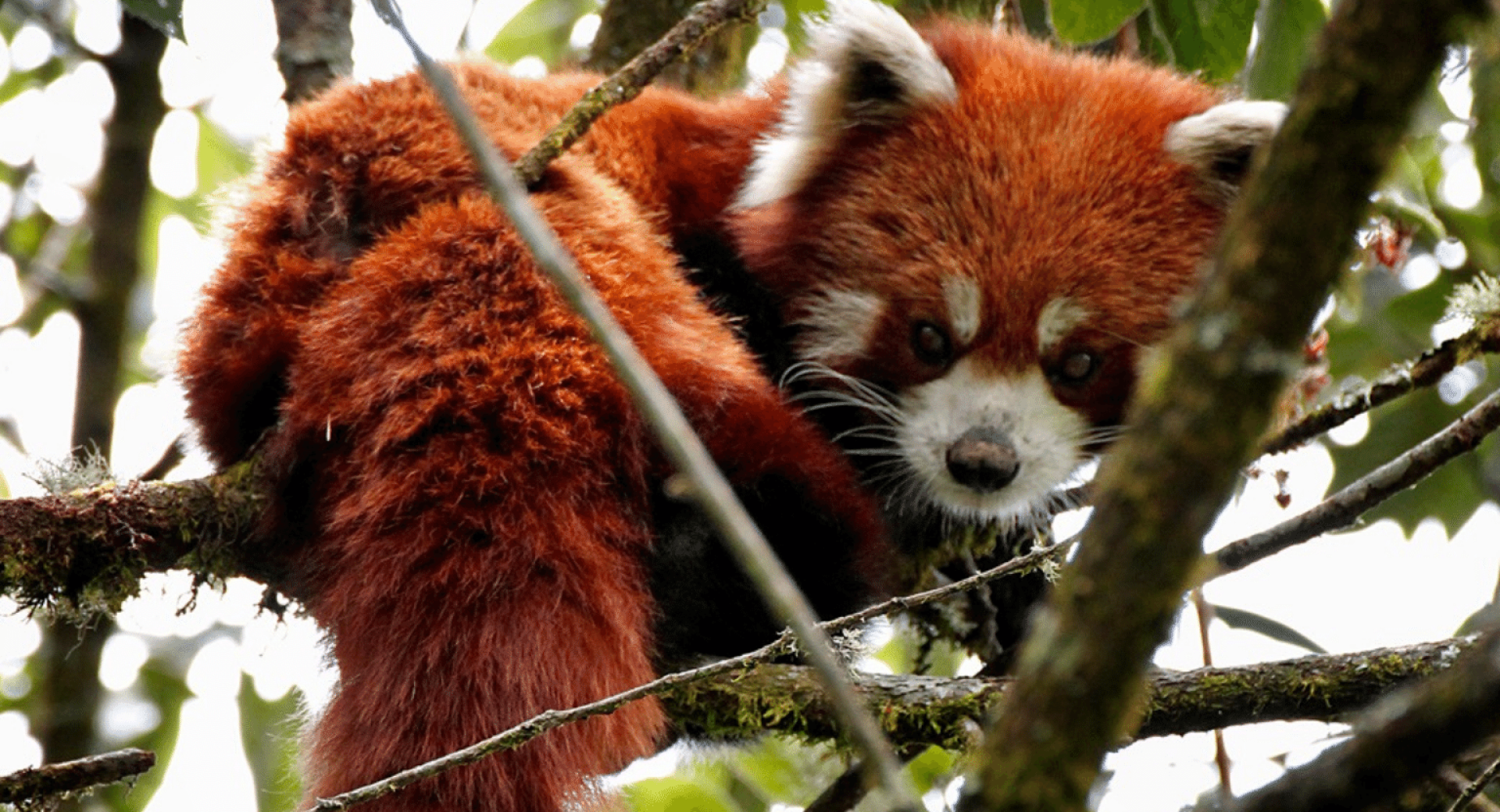
In October of 2013, myself and two co-workers from the Sacramento Zoo (Sacramento, California USA), Lead Carnivore Keeper Amanda Mayberry and General Curator Harrison Edell traveled to Nepal on a two week Red Panda Network Eco Trip. The Sacramento Zoo is currently home to six Red Pandas, including our newest addition, “Kodari” who was born at the zoo in June of 2013. The zoo is a supporter of Red Panda Network and the possibility of actually observing these amazing animals in their natural habitat of eastern Nepal was an opportunity that I could not turn down. As staff members of a zoo that puts great emphasis on wildlife conservation, we were not only hoping to see Red Pandas in their natural habitat, but also learn more about Red Panda Network’s work in the region.
Following a flight from Bangkok, Thailand where we had spent three days, our Nepal adventure began at the Tribhuvan International Airport in Kathmandu. We were met at the arrival gate by Red Panda Network staffers, Rajiv Paudel (our primary contact prior to the trip) and Damber Bista who would also be our guides for the next two weeks. This was my first trip overseas and thought I had an idea what to expect. Even so, the sights and sounds of Kathmandu were a bit overwhelming from the moment our taxi departed the airport parking lot. Kathmandu is a densely populated city whose infrastructure hasn’t quite caught up with the sheer number of people now living there. The taxi ride to our hotel had a bit of a “wild west” feel to it with a seemingly random flow of cars, motorcycles, bicycles, pedestrians, etc. and traffic laws that weren’t necessarily enforced, if there were any. We never felt like we were in danger, just something new to get used to.
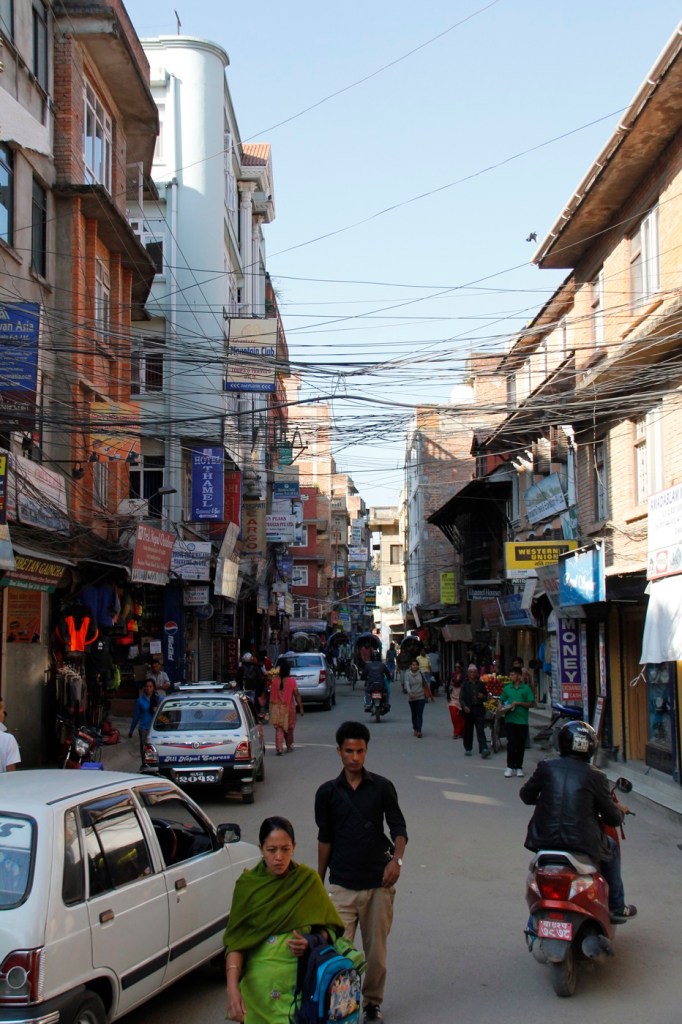
The Thamel district of Kathmandu
Our hotel was located in Thamel, one of the tourist oriented districts in Kathmandu with hotels and a myriad of shops offering everything from souvenirs and fabrics to expedition and trekking gear (all of the big name brands, but mostly “knock-off” merchandise). After unpacking in our comfortable rooms and catching our breaths, we took a quick trip to explore the Monkey Temple with its well-known resident Rhesus Macaques and overlooking the Kathmandu valley. Afterward, we were driven back to the central area of the city and Boudhanath, the largest stupa (temple) in Nepal. We enjoyed a pizza dinner at a restaurant across from the temple and had the opportunity to get to know the others in our group, a newlywed couple on their honeymoon (and RPN supporters) and a grad student (and RPN volunteer), all from the UK. After that and a bit of shopping in Thamel, we turned in for the evening in preparation for a flight to Bhadrapur in eastern Nepal.
After a good nights rest and breakfast, we took cab a ride back to Tribhuvan International, which was as “exciting”as on our arrival. Side note: on the first leg of our trip from San Francisco, Amanda’s duffel bag did not arrive in Bangkok when we did. Of course it contained most of the gear she would need for the trip. To the credit of the airline, her bag was located and knowing we would only be in Kathmandu for a day, overnight shipped to Tribhuvan safely where Amanda had the opportunity to be reunited with it before our flight to Bhadrapur.
We departed Kathmandu on a comfortable ATR-72 twin-engine turboprop commuter aircraft operated by Buddha Air, a regional airline serving Nepal. Fortunately, we had seating on the left side of the cabin that gave us breathtaking views of the Himalayas and of course, Mount Everest. The flight only lasted about 50 minutes before we touched down in Bhadrapur. From there we would be driven to Ilam near Nepal’s eastern border. Ilam is the tea capital of Nepal along with many other crops grown there. This would also be our “home base” between the various areas where we would be traveling. Although the roads in this area are well established, not all of them are paved. The ones that are can show the effects of large vehicle traffic and weather such as the annual monsoon rains. The hotel we stayed at in Ilam was nice, clean, had good food but either sporadic or no hot water in the rooms. There was a communal shower with hot water, so you took your choice of a cold shower in the privacy of your room or going downstairs and waiting in line for the communal one.
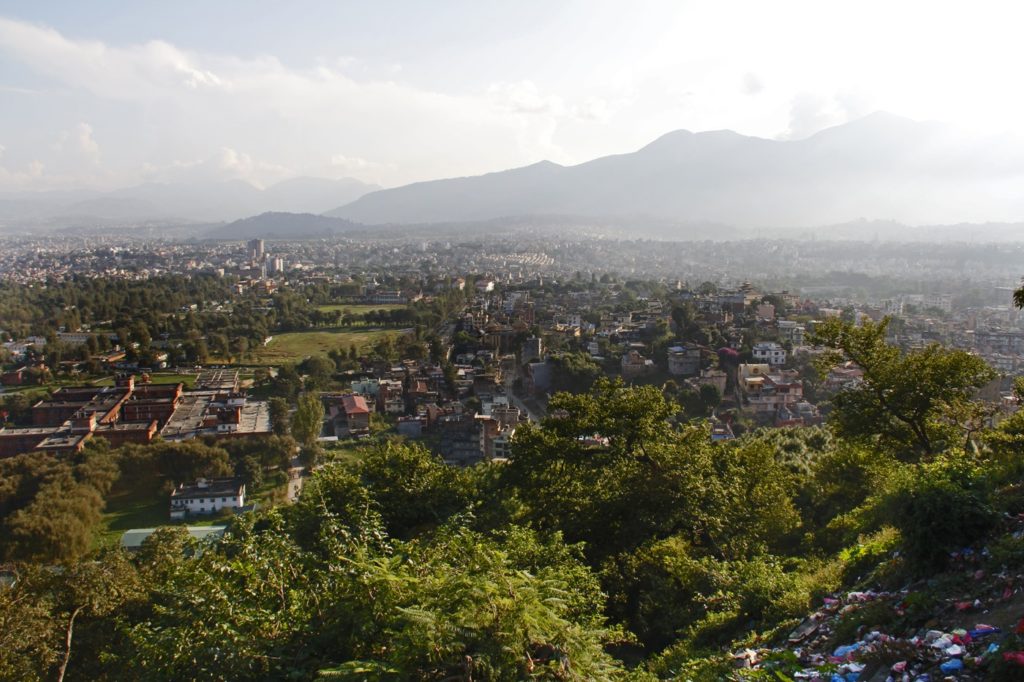 View of the Kathmandu Valley from Swayambhunath (Monkey Temple).
View of the Kathmandu Valley from Swayambhunath (Monkey Temple).
Our first trip into the field began early the next morning for a five-hour drive to Dobate. Much of the ride would be over the previously mentioned unpaved roadways, but again, it’s something you got used to. After the long, uneventful and often bumpy drive, we arrived in Dobate where we would stay at a nice, comfortable teahouse. The afternoon was spent on a short hike into the forest where we could get an idea of the red panda’s habitat.
The weather in October was very consistent during our stay in the mountains, sunny and pleasant until around noon when the clouds rolled in and would become somewhat cool and damp. This afternoon was no different and the hike gave us a chance to acclimate to the weather, altitude (we were all used to life at sea level) and hiking conditions.
Our hike the next day took us further into the Dobate area forest where we tried to keep a sharp lookout for any signs of a red panda. Along with Rajiv, we had other guides who were always knowledgeable, friendly, accommodating and helpful. One piece of equipment listed on RPN’s recommended gear list are trekking poles which I very much agree with. Although the trails are fairly well maintained, they can be slippery and rocky with lots of ascents and descents (where knees can take a beating), plus of course there’s the altitude. All of us who weren’t necessarily conditioned to hiking under these conditions found the poles to be invaluable.
After hiking a while with no sign of red pandas, we encountered a couple at a small village. Our guides spoke with them and asked if they had seen red pandas in their area. They said they do see pandas but wouldn’t reveal where because of concern that we might capture and take them away. On the one hand a little disappointing, on the other, was encouraging that they had a real concern for their wildlife.
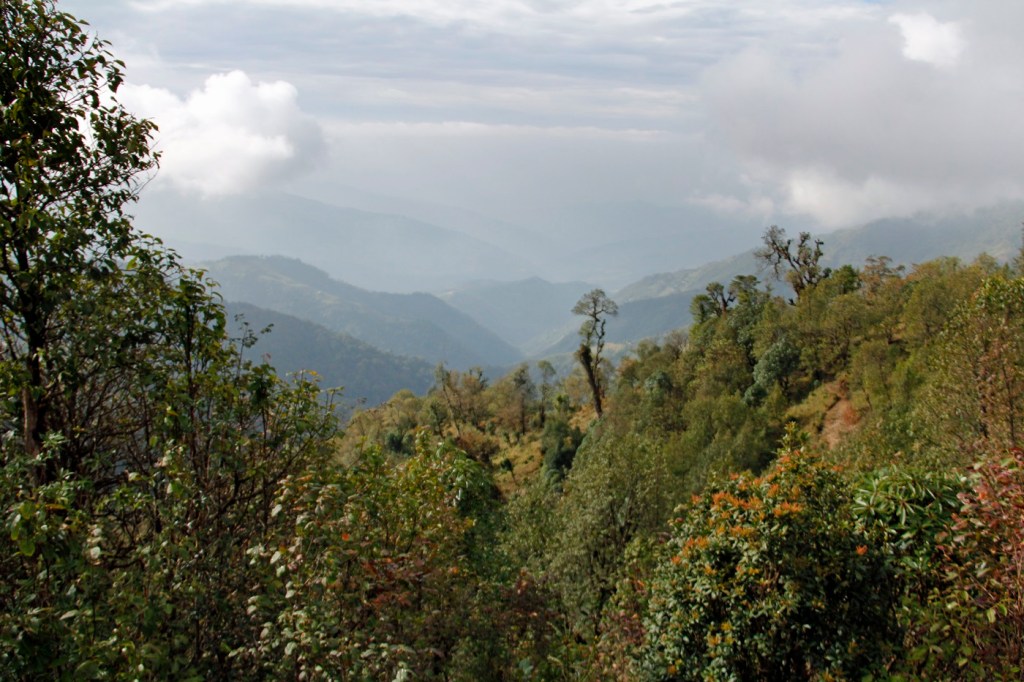 View from a trail near Dobate in eastern Nepal.
View from a trail near Dobate in eastern Nepal.
After a rest stop and a chance for our guides to do some searching of the forest area, we began our hike back. Along the way we were stopped by one of the guides who had spotted a red panda in the trees just off the trail. Sure enough there was a little red and white face peering out from the leaves watching us. We were fortunate that there was a steep hill that allowed us to get a just about perfect vantage point to observe the subject of our 7,000+ mile journey. The red panda didn’t appear at all stressed or bothered by our presence which gave us an excellent opportunity to observe and capture photographs. After a period of mutual observation, the panda turned, climbed a bit higher into the tree where he found clusters of berries, which he consumed and then headed off into the forest. Elated, we climbed back down the hill and returned to celebrate and review the tiny images on our digital cameras.
This would be the only red panda we would see during our time in Nepal. We were told one Eco Trip group had seen six pandas, but there is always that possibility of not seeing any. That’s always a possibility when observing wildlife in their natural habitat, but the guides working with Red Panda Network know these mountains and the animals that live there, so the odds of actually seeing a red panda are probably quite high.
We spent two more days in Dobate to explore the area and travel to Sandakpur in the hopes of a sunrise view of Mt. Everest and Mt. Kanchenjunga, the third tallest mountain in the Himalayan range. Although planned to be a six hour uphill hike to Sandakpur, our group opted to take the Land Rovers, a decision we would later not regret. Sandakpur is a popular stopping point for trekkers with several lodges located on either side of the Nepal-India border which runs right through the village. As Sandakpur is located at almost 12,000 ft., we were prepared for cold weather overnight and in the predawn hours when we would hike a short distance to a mountaintop with a view of the Himalayas. After waking up well before sunrise, we wearily made our way up the peak to wait for the expected view. At the time, the weather was very cold and cloudy and we couldn’t see much past a few hundred feet, but were hoping it would clear by the time the sun made it’s appearance.
As it turns out, the sun never broke through so we hiked back to the lodge just in time for rain to begin. Our departure from Sandakpur was delayed due to the cold temperatures overnight, which affected one of the Land Rovers’ fuel system. Eventually the driver got our vehicle started and we rode back down the mountain, grateful we weren’t hiking in the rain. We packed up, said our goodbyes to our hosts in Dobate and returned to Ilam.
In Ilam we enjoyed a walk past the tea fields, taking a look into a tea factory and a bit of shopping in town (to purchase some Ilam tea, of course). We also stopped by the office of a conservation group and partner organization of Red Panda Network where we learned about their work in the region.
The plan for the next day would be a 7-8 hour drive toward our next destination, Kalikhola. About half of the drive would be on unpaved roads. Nepal is currently in the process of building and improving this east-west road which will eventually be paved and include bridges to make travel through the region much more reliable, especially during the monsoon season.
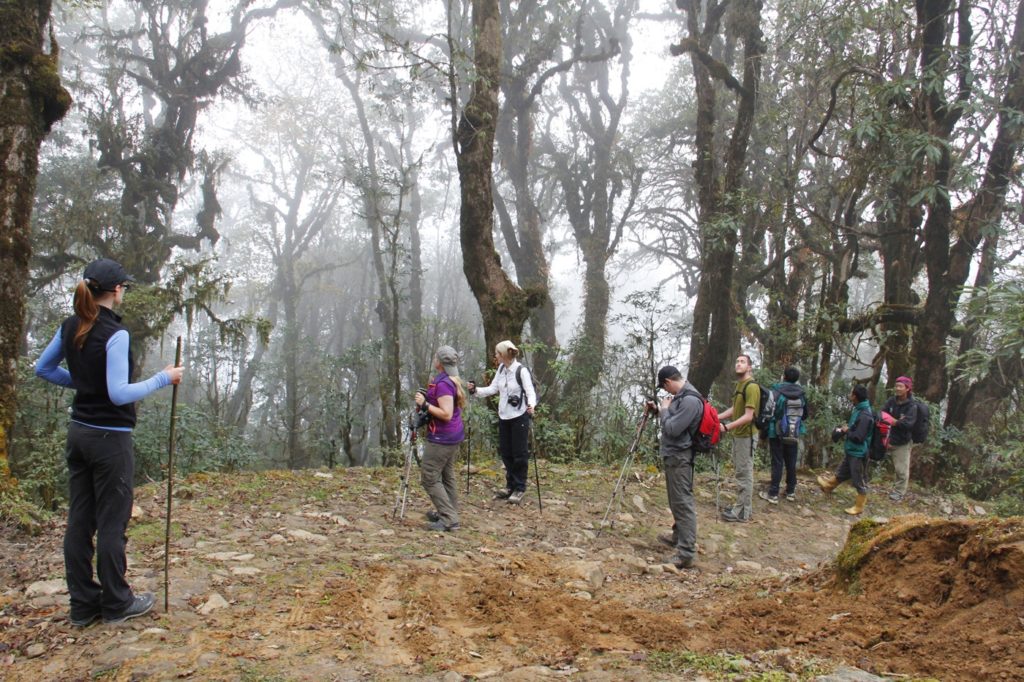 Hiking between Dobate and the Nepal-India border
Hiking between Dobate and the Nepal-India border
There are no roads leading directly to Kalikhola so we would have to hike an estimated four hours to reach our destination where we would spend the next few days. That plan was altered when it was discovered road repair from a previous night’s washout required us to begin our hike near the bottom of the valley and make up time from there. The time estimate for the hike was also optimistic for our group as it took a total of about 8 hours to reach Kalikhola and necessitated a stay at the home of a generous family who put us up for the night.
That hike up the valley turned out to be much more strenuous than imagined, but we eventually reached our destination a day late, but were warmly welcomed by residents of the village. After some needed recovery time, our group met with leaders of the village to discuss conservation and also how we might be able to encourage travel to their area, thus bringing more income to the region. I would imagine people; especially the children don’t frequently see “westerners” in this area so we were the subjects of a great deal of curiosity. As with our other experiences in Nepal, everyone was friendly and hospitable. One form of unexpected, not so welcome wildlife discovered by our group was the nocturnal, almost hand-sized spiders that occupied the outhouse in the evening.
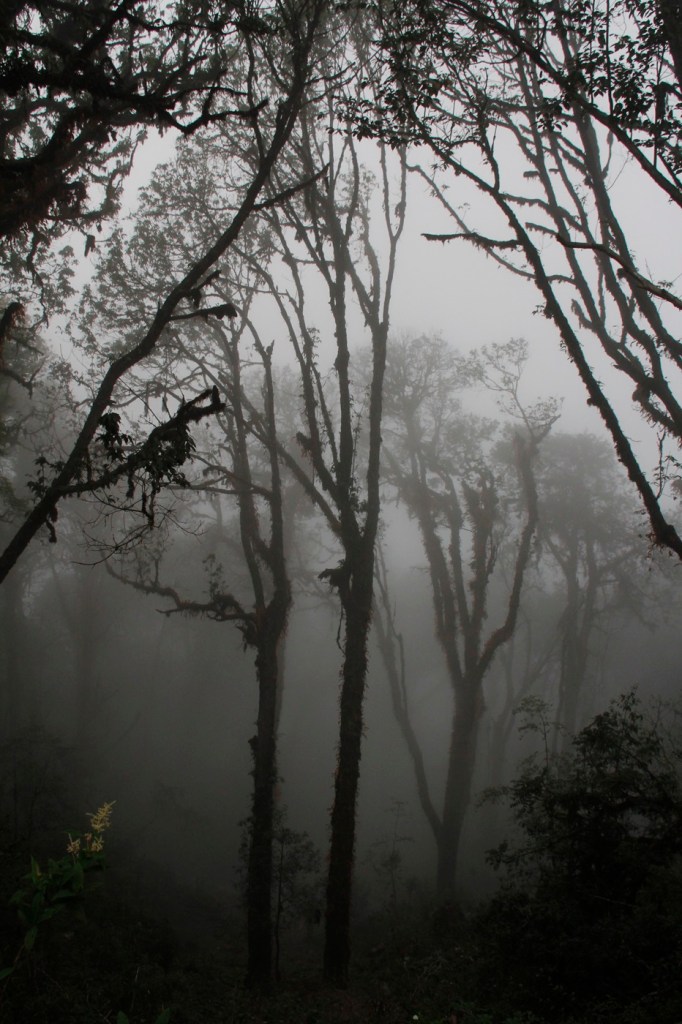 Mountain forest in Dobate as afternoon clouds move
Mountain forest in Dobate as afternoon clouds move
I should probably mention something about food during the trip. A staple of the Nepali diet is Dal Bhat, which consists of rice and lentil soup with the addition of greens, curried vegetables and perhaps some meat such as chicken. It’s served in generous portions (with repeat helpings often whether you ask or not) at least two or three times a day. It’s a high carb diet that is useful when you’re exerting yourself at high altitudes. With our western palates conditioned to a more varied diet, multiple servings of Dal Bhat everyday can be a bit monotonous if you haven’t grown up on it. Our generous hosts did their best to change the dishes up with the constraints of what was available and we appreciated their efforts. We had also brought a variety of snacks and energy bars that was also a wise decision.
Our second day in Kalikhola was spent hiking to a location closer to the forest where the guides were scouting for red pandas. Unfortunately, there was no sign of them in the area so we returned to the village where we later enjoyed a large group dinner along with singing and dancing by members of the village.
The next days hike back down the valley to the waiting vehicles was much easier and took about half the time. The views of the valley and waterfalls helped make the hike go by quickly. After the long drive, we arrived back in Ilam for one final evening before heading to Bhadrapur and flight back to Kathmandu. The flight from Bhadrapur to Kathmandu was delayed due to weather, but the benefit was an unforgettable view of the Himalayas illuminated by the light of a setting sun.
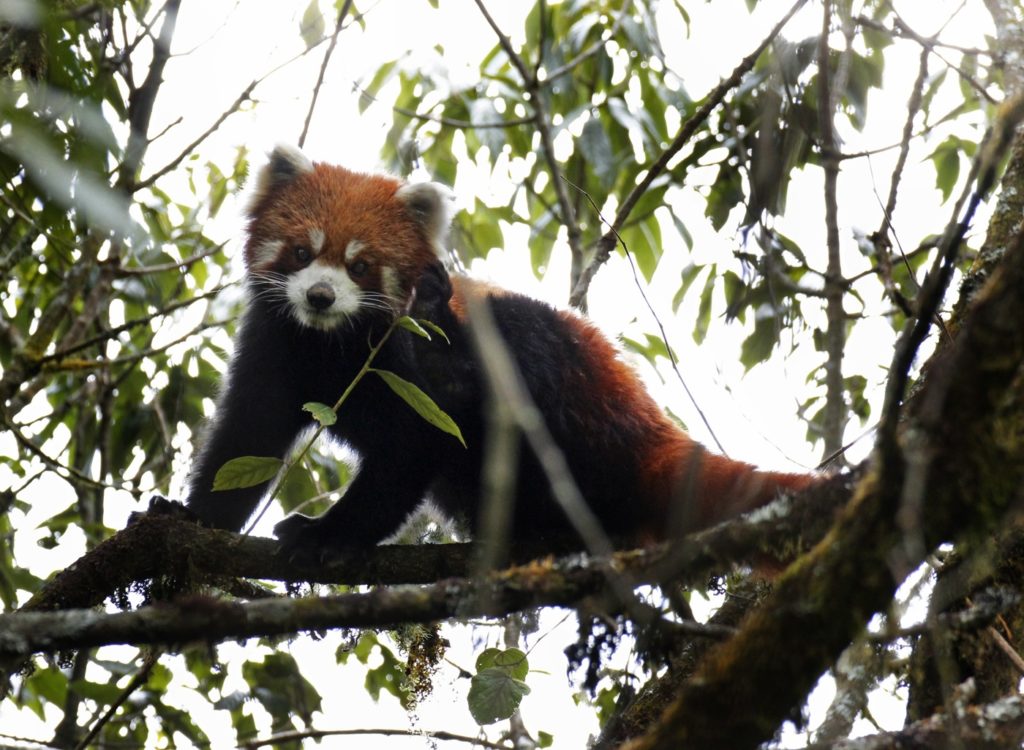 Red Panda observed in the Dobate forest.
Red Panda observed in the Dobate forest.
We enjoyed one more night in Kathmandu with dinner, a little more shopping and planning for our respective next day departures from Nepal. That final morning we did some last minute shopping, said good-bye to our traveling companions and Nepal.
Overall, our Eco Trip was an unforgettable and rewarding experience. It wasn’t without a few bumps along the way, but traveling to this part of the world, seeing its wildlife and meeting its people is something we will never forget. I would highly recommend the Red Panda Network Eco Trip experience to just about anyone with an interest in wildlife and nature.
-Mike Owyang
If you are interested in coordinating an EcoTrip with RPN in Nepal please check out:(http://redpandanetwork.
